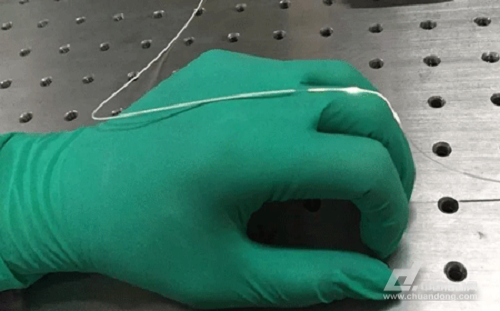With the proliferation of various wearable devices, the demand for various wearable sensors is increasing. These sensors can be attached to the body and can be integrated into the clothing, so that athletes can better monitor their movements, and physical therapists can be used to help patients recover, and can also help computer games and animations to make fine motion captures. Help engineers create robots that can make soft touch, or form a new real-time health monitoring device.

Actually, to accurately capture the movement of the human body is very complicated. Our hands, feet, various parts of the body, facial expressions, etc., there are often complex bending and deformation. At present, there are very good electronic strain sensors, but they are often influenced and limited by external electromagnetic fields.
Optical fiber sensors can be very good to avoid the above effects. Fiber-optic sensors have long been available and have been used in many applications for measuring buildings and bridges. When the fiber bends, light passes through it and is affected. Optical fiber sensors can measure such changes and then use computers to convert the data into forces that affect bridges and buildings. However, the current optical fiber sensor materials are usually glass or brittle plastics, which can be damaged by a few degrees of deformation. This makes it difficult for existing fiber optic sensors to be used in wearable devices.
The Changxi Yang team from the State Key Laboratory of Precision Measurement Technology and Instruments at Tsinghua University published a study in the magazine Optica, demonstrating for the first time an elastic fiber that can sense a wide range of human motion.
This new type of fiber is both sensitive and flexible and can detect the motion of the joint, which is different from the currently used optical fiber sensor. Yang said: "This new technology provides a fiber optic method for measuring extremely large deformations. It can be worn, mounted, and has the inherent advantages of optical fiber, such as inherent electrical safety and immunity to electromagnetic interference. â€
Stretching problems
Traditional optical fibers are not the best choice for human sensing because they are usually made of hard plastic or glass, they are hard and brittle, and are not easily bent. For example, silica glass fiber can withstand a maximum of 1 % of strain, while curved finger joints will deform more than 30%. Obviously, such a fiber is difficult to apply to flexible and complicated body deformation.
This hurdle means that most of the wearable sensors developed so far are based on electronic sensors. These sensors detect motion by measuring changes in electrical properties such as the resistance of the sensor when it is bent. However, these systems are difficult to miniaturize, lose their charge, and are sensitive to electromagnetic interference in devices such as automobiles and cell phones.
A flexible fiber can avoid these problems well and may create a more stable and sustainable wearable device than electronics.
Material screening
Researchers began to look for a fiber that could withstand the bending and stretching of human motion. They first tried fibers made from hydrogels. It is well known that hydrogels are soft, colloidal substances that can withstand strains up to 700%. However, hydrogels mainly consist of water and therefore can only work in wet environments. When exposed to air, the fiber quickly dries and shrinks, a feature that limits the use of hydrogel as a fiber optic material.
In the second attempt, Yang and his students JingjingGuo and MengxuanNiu jointly developed a fiber made of silicon, a soft polymer called polydimethylsiloxane (PDMS). They heated the liquid silicone into a tube mold to 80°C for 40 minutes, and then used water pressure to push the end of the fiber mold to make fibers. They have doubled the fiber length through a series of well-designed tests such as repeated stretching. Even after 500 stretches, the PDMS fiber returned to its original length.
"The PDMS fibers we manufacture have good mechanical flexibility and are easily tied and twisted," says Yang. More importantly, when the team reduced the diameter of the fiber, from 2 mm to 0.5 mm, the mechanical strength of the fiber actually increased.
In order to make the silica fiber sensor function, the researchers mixed a fluorescent dye called rhodamine B into silica gel. As the light passes through the fiber, some of the light is absorbed by the dye—the more fibers are drawn, the more light the dye absorbs. So simply measuring the transmitted light with a spectroscope can measure the extent to which the fiber is stretched or bent so that it can reflect the movement of any part of the body to which it is attached.
Glove testing
To test whether this silicone fiber was as effective as expected, they stuck the fiber to rubber gloves with epoxy, and the wearer bent and stretched his fingers to monitor it. In this process, they measured the strain applied to the fibers at 36%, which is consistent with other measurements using electronic sensors.
This sensor also performs well in the face of more subtle pressures, such as when a person breathes or speaks, the tiny movements of the neck muscles. "All the results show that optical strain sensors can be used to monitor a variety of human movements and may provide a new way for human-machine interface exploration," said Yang.
Piezo Ceramic Sounding Plate,Full Range Piezo Ceramic Buzzer Element,Piezoelectric Ceramic Diaphragm
NINGBO SANCO ELECTRONICS CO., LTD. , https://www.sancobuzzer.com